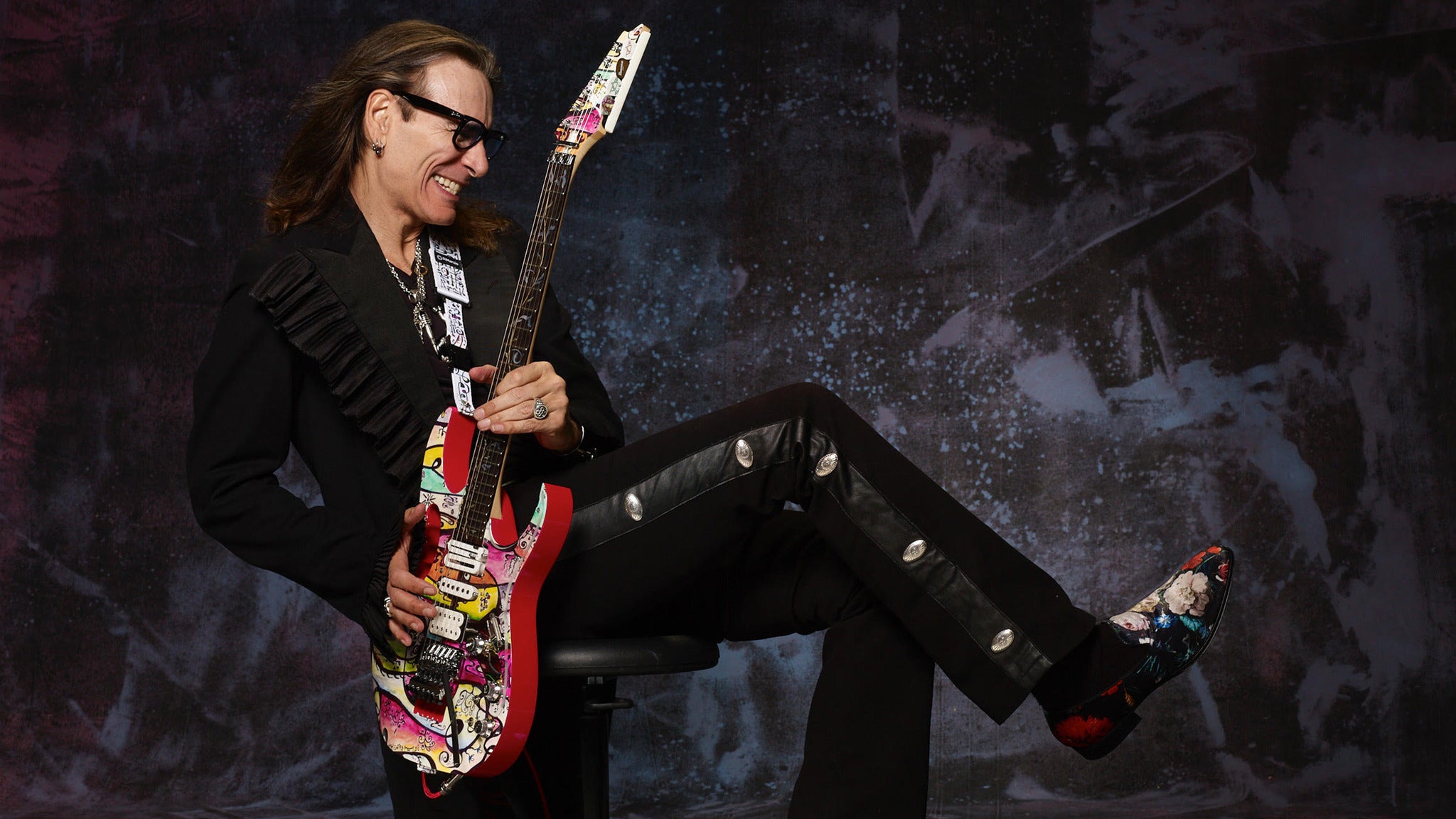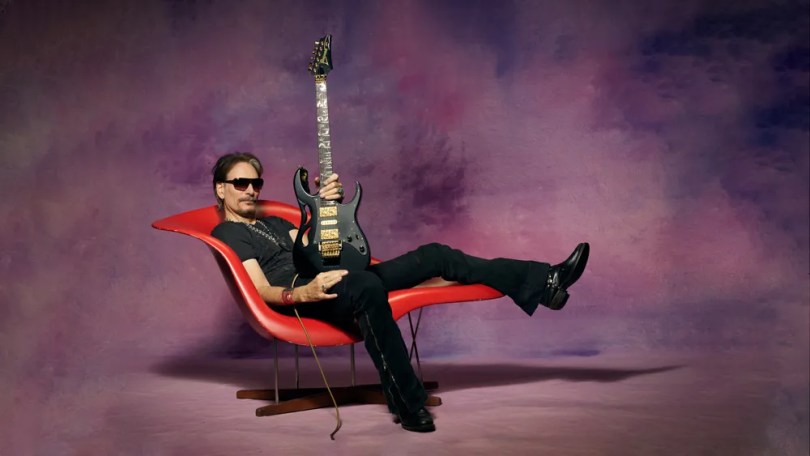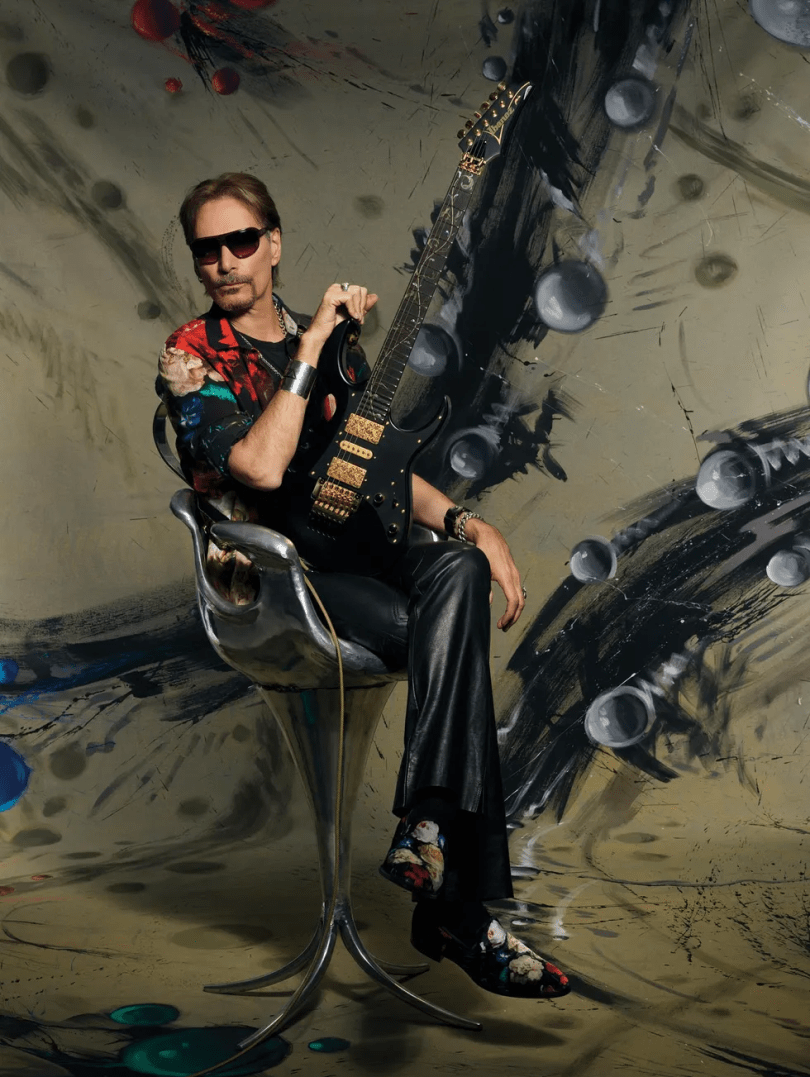
Header image credit: Larry DiMarzio

From the embryonic stages of Steve Vai’s career in music, he yearned for something more beyond what his minds-eye could grasp, or what his nimbly gifted fingers could produce.
In the face of fame, fortune, and guitar god status, Vai kept pushing, and in doing so, forged his own path to virtuosic immortality.
With roots anchored deep in rock and metal music, Vai emerged in the early 80s amongst a group of players who would come to be collectively known for their technical prowess in the midst of a scene aptly labeled “the 1980s virtuoso guitar boom.”
Vai’s formative years saw him move from one high-profile gig to the next as he climbed the proverbial rock ‘n’ roll ladder, beginning with Frank Zappa, and then moving on to Alcatrazz, David Lee Roth, and finally, world-dominating success with David Coverdale’s Whitesnake.
While success proved fruitful, a still young, and ever-curious Vai understood the fleeting nature of a double-dealing business, and perhaps forecasting the sonic changes ahead, Vai pivoted, making a hard left turn, succumbed to his hearts desires, and predisposition for compositional music, and in 1990, Vai released Passion and Warfare, the first of many mind-bending solo efforts, which cater to his deepest passion, grandiose swells of kaleidoscopic talent, and effervescent whims all at once.
At the time, Vai thought he committed something akin to career suicide, but in reality, Vai’s success, stature, and relevance only continued to grow.
Present-day, Vai is as active as ever, with the veteran six-stringer still unleashing his torrid accelerations of vivid brilliance, this time in the form of his latest studio affair, Inviolate, an album which features a staggering roster of players, an appearance by the now legendary, and years-in-the-making, Hydra, and the conspicuous, divination-driven instrumental guitar mastery that only Steve Vai can deliver.
I recently sat down with Steve Vai to discuss, among other things, his latest album, Inviolate, the creation of the Hydra, the influence of Frank Zappa, guitar-driven music in the 80s, and more.
Andrew:
Steve, thank you for carving out a portion of your day. Let’s dig right in. Your latest new album is titled Inviolate. What are the origins there?
Steve:
Well, that was a word that I came across some years ago, and I looked up the meaning and I really was moved by the word. I thought it was something that could end up being a good album title, so I kind of held it in the back of my mind, and basically what the word means, inviolate, is to be free from harm, unable to violate, pure, untouchable. When I came across that meeting, and the word itself, it was in a spiritual book, and it was in reference to the human soul, the spirits, the being of us as humans, as the one thing that’s inviolate.
Andrew:
Given the album’s title, what would you say the musical through-line of the new album is?
Steve:
Well, I use the title sort of as an analogy to the human spirit, and its creative nature. And what I mean by that is, everybody has a unique, creative potential, and we’re inspired to be creative from something that arises in us as a good idea, an “aha moment,” or a realization of a creative idea. These ideas come naturally to us, and they’re tailor-made specifically for us, based on the gifts that we have, our natural inclinations, and those things that interest us. And when an idea comes to me, based on those authentic, creative desires, I use that as a sort of an environmental idea, meaning it’s tailor-made for me to bring into the world. Unfortunately, what happens is, most humans have these creative impulses, but then they become obscured by the little voice in their head, insecurities, and fears that cut out the root of their ability to be uniquely creatively inspired. So, I chase those fantasies in my music.
Andrew:
When I listen to Inviolate, I get the overall sense that this record, moreso than your last [Modern Primitive], is a BIT more melody-driven. I think it would be a really good introductory record for new fans. How does your approach change from record to record?
Steve:
Well, I agree with you. Before I began recording Inviolate, I knew I wanted to create a group of songs that had the best melody I could write. And I do that, for the most part, the best I can in a lot of my songs, but sometimes I focus on different things, and the melody may give way to something like an interesting technique that I was working on. Even with something obtuse and quirky in my playing, I still try to flip it with melody, you know what I mean? And then sometimes, I’ll do things that are just a display of virtuosity, I’ll work on something that’s kind of like at the peak of my ability, there may not be much melody in it, but there’s a fascination, right? Ultimately, the melody is what has longevity, and the shelf-life of a piece of music is directly joined at the hip with the quality of its melody.

Andrew:
You’ve just alluded to your affinity for melody-driven music merging with your virtuosity, in that vein, how do you keep yourself pushing forward without stagnating?
Steve:
Well, because I’m focused on something I love doing, and that’s been the case for me, fortunately, since I was very young. I never decided to be a musician, because that would have meant that there was another option, and I never even considered another option. There was never a moment where I thought, “What should I do? Should I be a musician? Should I do this, or something else?” There wasn’t even a remote alternative option. I knew instinctually that the creative process is infinite, you’re never going to tap out your inspiration, it’s impossible. The only thing that can limit your inspiration is your belief that it has limits, which is like saying that’s that the universe is limited. A lot of people know that their ability has to evolve, that their creativity is infinite, and that it’s never going to end. So, that’s real, that’s where the joy comes from because for someone like myself, the thing that’s most exciting to me, is when I feel like I’m being inspired by an idea, something that resonates with me, something that says, “Yes, you can do that, and you want to do that.” For me, that’s never going to end, but it may show itself more subtly, in various forms. For instance, I’m going to Holland in May, to record about four hours of my orchestral music with the Metropole Orchestra, and even within all of this orchestral music, I apply the same creative non-limitations, so to speak. You’re not going to hear it and go, “Oh, that would have sounded good on the guitar,” or anything like that, it’s in a completely different field. And that in that field, the compositional field, the ability to expand your creativity, with the tools you have is remarkable, because you have one hundred people playing every little thing that you write. It’s fantastic.
Andrew:
Who is your backing band on Inviolate, Steve?
Steve:
For the most part, it’s my band that I’ve had for about twenty years, and that’s Philip Bynoe on bass, Jeremy Colson on drums, Dave Weiner on guitar, but given the last two years, and the way that we’ve had to create music, there was a lot of advantages that I discovered by communicating with other musicians by sending files and just having them do their thing, so to speak. So, I was able to reach out to a lot of other musicians that I felt would be appropriate for a particular track. For instance, “Little Pretty” has Bryan Beller on bass, and he did a spectacular job because that’s a song, melodically and harmonically, is a beast to play through. And then with “Candle Power,” I have Terry Bozzio on drums, and that was fantastic because I originally recorded and released that song as just a drum loop. I released it as a video during the lockdown, and then I felt like the song needed Terry, so I sent it to him, and he was kind enough to lay down a spectacular drum part. Then there’s “Avalancha,” which has Billy Sheehan on bass, which was one of the reasons I wanted to complete that song because it was tracked with bass and drums way back in the Real Illusions sessions.
And then you’ve got “Apollo In Color,” and that was a really nice opportunity to send that track out to some kingpin fusion players that I knew were going to lay down some wild shapes. The track has Vinnie, Colaiuta on drums, and Henrik Linder on bass, who I’ve been following for a while - the kid is a freakazoid - and he laid down such a great part. There’s “Greenish Blues,” and that’s my band, then “Knapsack,” I recorded all of the stuff for “Knapsack,” and then Dave Rosenthal, a keyboard player, and a friend of mine that I met my first day at Berkeley, he’s been a dear friend ever since. Dave’s gone on to be an incredibly successful keyboardist, and has been Billy Joel’s musical director for the past twenty-five years, he laid down a bunch of keyboards. He did “Apollo In Color,” and a few others. And then there’s “Sandman Cloud Mist,” which was another track that had Vinnie Colaiuta do, I had him on my mind for that one, and he laid down another great part. Overall, it was easy for me because I just sent them the tracks, and then they laid them down.
Andrew:
I wanted to touch on the Hydra guitar, which is a very interesting piece of gear. If you could, give us the backstory on that guitar, and its role as it pertains to Inviolate.
Steve:
I’ve always been attracted to multi-neck guitars, and I’ve had many made in the past, but I never felt like I could really utilize them in a piece of music. So, probably about seven or so years ago, I had an inspiration to create a guitar where I could perform a piece of music, and everything would be done on that guitar, where the only other thing on the track would be some keyboards and drums. I knew that it would require a dexterity and limb independence that I didn’t have, but I knew I could develop it. I also knew that the instrument needed to have a bass neck, and I wanted to have a seven-string neck, a twelve-string neck, and harp strings. I also wanted it to be a highly technical instrument, and so, we started working on it probably about seven years ago. I was also kind of into steampunk fashion at the time, so I took my ideas and sent some steampunk-type clips and everything to Ibanez, and they did a rendering, and that turned out to be the Hydra. I was stunned when I saw the rendering, and then for some years after that, we just went back and forth. Finally, I got the guitar, and it just sat in the studio for about a year on a stand, and every time I passed it, I would just think, “Oh my god, what am I gonna do with this thing?” It would just hiss at me, and say things like, “You know you’ve got to play me, Vai.” [Laughs].
So one day, I made a decision, I carved out six weeks, and just sat behind the Hydra, and I had a visualization of the kind of movement that was necessary. I knew first and foremost that it needed to end up sounding like a standalone piece of music that had an enjoyable melody and could be experienced without the limitations of the guitar itself. Because when you’re playing the Hydra, you can’t really pound on the bass neck and the guitar neck at the same time, because you’ve only got two arms, so I had to create this linear action to make this track flow, and it was a lot of fun. And when it started to click, I really was beside myself, because when you visualize something and you can’t do it, and then you just start working, it seems impossible, but once you start working on it, it doesn’t seem impossible anymore because you’re actually working towards it. When you work, and work, and work on it, you play with it, you move it around, and work on it some more, and then all of a sudden that comes together, that’s the real treasure. Listening to it, when it’s done perfectly is really nice. When it clicks, the feeling you get is, I’ll use the word “euphoria,” and that’s addictive.

Andrew:
That has to be an incredible sense of accomplishment to have visualized the guitar, creating it over several years, and then finally using it in creating music in which you’ve seen that vision through post to post.
Steve:
It’s like heaven in a cup. When you see the video that we shot, that I’m editing now, it’ll explain a lot of things.
Andrew:
Early in your career, you worked with Frank Zappa, who was a consummate fusion musician, and an incredible guitarist in his own right. What did you take away from your time with Frank which has helped inform your style in a way that is still represented today?
Steve:
There isn’t a day that doesn’t pass where I don’t reflect on the things I learned in my Zappa years because I was so young and so impressionable. Frank was Frank, and he did things that were inspirational to him, and he never made excuses. That’s one of the things I got from him - that was the greatest thing - he did what he wanted, because he was a free thinker, and he enjoyed what he was doing. That’s in contrast to the way a lot of people approached their careers - they fight-fight-fight - Frank just did-did-did. I learned that, among many other things. As far as Frank’s guitar playing goes, I’m intimately aware of his playing because I transcribed it for four years. I worked at writing down these crazy guitar parts, and he was a very visceral type of a player, he wasn’t a refined guitar player, he didn’t play all those bizarre melodies, and arranged parts very often. Frank was more visceral, more of a powerhouse when he approached his solos and stuff, and that was inspirational for me to watch and learn from.
Andrew:
As the 80s rolled on, you had your time with Alcatrazz, David Lee Roth, and then Whitesnake. How do you reconcile two very different aspects of your playing in terms of the hard rock side, and the fusion side?
Steve:
I can enjoy going to a pancake house and having pancakes, and then at night, I can enjoy going to a fancy restaurant. [Laughs]. My dining pleasures are based on my appetite, and it’s the same thing with my guitar playing. When I was a young teen in the 70s, I was lit up big time by the rock music of that period, like Led Zeppelin, Queen, Deep Purple, and all those great players. I loved rock music, I absolutely loved it. I was in rock bands, and we played KISS, Aerosmith, Alice Cooper, all of these rock bands, and I loved the feeling of it. At the same time, long before I even picked up the guitar, I was inspired by compositional music when I was around six years old, and even then, I wanted to be a composer. I knew I wanted to do that, even at that age. I understood what the little dots meant, the little black dots, and I understood that if you can arrange them in a particular way, people will follow what you write and that this was an explosive creative field, and I wanted to own it. So, all through my early years, I listened to all kinds of classical music, and I’d doodle notes, and then, when I was maybe ten or eleven, I started to compose. And when I was twelve, I entered a high school music theory class for twelfth graders, and for six years, every day, I was heavily trained in compositional music.
At the same time, on the other side of the tracks, we’re stealing lights from people’s lawns to use in our light show at our gigs. We were doing high school dances and blowing up smoke bombs, and stuff on stage, it was just the best. [Laughs]. When I heard Frank [Zappa’s] music when I was young, it had such an impact on me, because he was doing it all, he was merging all of those things, and I thought, “Wow, I can do anything I want, really.” So, I entered the realm of the 80s rock bands and played with all those bands you mentioned, and I really enjoyed it. I felt like I wore that badge proudly, and authentically because that music was in my blood. It was the wonderful pancakes at the pancake house, you know what I’m saying? But throughout all of it, I knew that at some point, this unique kind of quirky music that I had in my head had to come out, and when I was twenty-five, I started working on Passion and Warfare, and it’s just never ended.

Andrew:
The guitar-driven music created during the “virtuoso guitar boom” is passionately revered. Looking back, in your estimation, how do you measure the accomplishments of both yourself and your peers?
Steve:
I knew that I was different, then again, I knew everybody was different, but I never felt like I was the best or anything like that. As a matter of fact, I always felt that everybody else had something going on in their playing that I was missing. I didn’t know what it was but having said that, I liked what I was doing. I liked the way I played. I loved it. It was quirky, it had some humor in it, and sometimes, it had an intensity, and it was very melody-driven. Unlike my contemporaries at the time, I focused on doing instrumental solo music at some point, while a lot of those guys continued with rock bands and stuff. I’m a composer, in a sense, and there are only a few people I know who balance the two fields of rock and composition, but one of them is Kip Winger. Kip and I became very good friends, and he is an excellent composer, but I really don’t know many others. There was that extra little bit of DNA that I had that was a little different. But there were some great players back then, everybody was blowing up the bridge in the 80s. All of us were kind of like, looking at what was what we learned in the 70s when we were younger, and watching all those great guitarists, and feeling like, “Okay, this is where we have to start, that’s how it works.” You know, that’s the way it works in sports, and in business, you stand on the shoulders of those who came before you, and we were doing that.
Looking back, it was an exciting time because we were unleashing the virtuosic abilities of the instrument. All of a sudden you had guys like Yngwie [Malmsteen], [Joe] Satriani, and [John] Petrucci, these guys that were just completely astonishing when they played. So, that was a very fertile period for guys that really wanted to play the shit out of the guitar, but then like anything, genres and trends changed and grunge came in, and it basically came killed the electric guitar solo. It killed was the idea of being a virtuoso because it painted it as an uncool picture, and in some respects, that field of virtuoso guitar playing was drifting off into insipidness. It was becoming pretty insipid, it was just the pantomiming of somebody else’s genius. You had people shredding for the sake of doing it, and there’s a fascination and an audience for that, but upon deeper investigation, it just doesn’t have the shelf-life, so to speak.
And then when grunge came along, there were guys writing really great, inspired, and simple songs, turning them up through distorted guitars, and making some completely different kinds of noise. So, just like any period, where there’s a changing of the guard, or a closing of the old, and a birth of the new, many of the people that see this change, and don’t really have a secure identity, will chase after trends. And in chasing the trend, very similar to not wanting to be left out, not wanting to be seen as not part of the right group, you start fooling with anything that came before it, and you jump on the bandwagon of whatever seems conventional at that time. So, that happens with the vast majority of people, but there are always those that will look around and say, “This is insipid. I’m doing something completely different.”
Andrew:
To that end, did you ever feel restricted during your time with Alcatrazz, David Lee Roth, or Whitesnake?
Steve:
On one level, absolutely not. You know, on one level, I was pushing myself, joyfully, to the absolute end of my ability, because the platform was there, I had to deliver. I wasn’t going to try to deliver like Yngwie in Alcatrazz or Eddie [Van Halen] with David Lee Roth, or John Sykes with Whitesnake - I couldn’t. But I knew that I could deliver something, and I threw myself into it, and it was great. But I knew, as I was going through it, I was living a particular fantasy of being a Rock Star, and I knew it was fleeting, and I was totally okay with that. I didn’t want to chase that for the rest of my life. I knew that the timing was right, and I had the opportunity to travel the world, to play to sold-out arenas, be treated like a king, make a gob of money, and make great music with great guys. I also knew that it was going to come to an end because I had to, at some point, start doing this other type of music, and when I started to do it, and I recorded Passion and Warfare, I actually thought my career was over. Surprise, surprise. [Laughs].
Andrew:
Well, Steve, Inviolate is an incredible testament to the passion and drive to create that you innately possess. In the immediate future, what’s next on your docket?
Steve:
Right on, brother. Well, the first thing is, in May I go to Holland to record this orchestral music, and then we go right from there to Europe for a fifty show, European tour. Then, I go right from there to Mexico, and then to South America where I’ll be doing Rock In Rio with Living Color. I go right from there to an American tour, and right from there to my camp, and then to Africa and Indonesia. And then it’s Christmas, and based on what state the world is in at that time, well, I was planning on performing all through Russia and China, because I have a great following there, and they’re great music lovers, but because of the condition of politics now, I don’t think that that’s going to happen. To that end, only time will tell.

Interested in learning more about Steve Vai’s newest offering, Inviolate? Hit the link below:
Be sure to check out the full catalog of VWMusic Interviews, by Andrew Daly, here: www.vinylwritermusic.com/interviews
